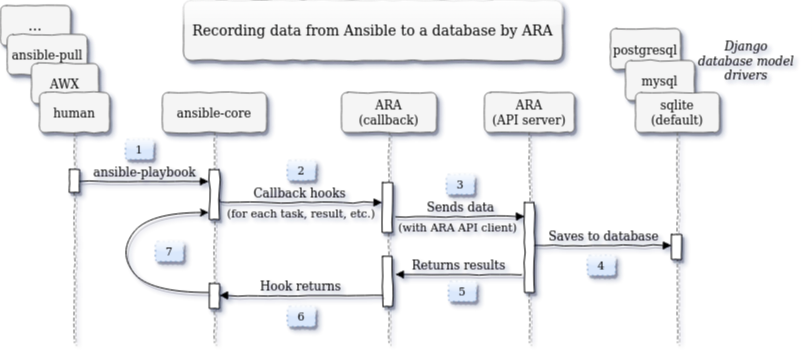ARA Records Ansible and makes it easier to understand and troubleshoot.
It's another recursive acronym and features simplicity as a core principle.
ara provides Ansible reporting by recording ansible and ansible-playbook commands wherever and however they are run:
- from a terminal, by hand or from a script
- from a laptop, desktop, server, VM or container
- for development, CI or production
- from most Linux distributions and even on Mac OS (as long as you have
python >= 3.6) - from tools that run playbooks such as AWX & Automation Controller (Tower), ansible-(pull|test|runner|navigator) and Molecule
- from CI/CD platforms such as Jenkins, GitHub Actions, GitLab CI, Rundeck and Zuul
In addition to the built-in CLI, the data is made available through an included reporting interface as well as a REST API.
Note: open the above gifs in a new tab (or window) if the resolution is too small
ara records results to sqlite, mysql and postgresql databases with a standard Ansible callback plugin.
The callback plugin leverages built-in python API clients to send data to a REST API server:
- Any recent Linux distribution or Mac OS with python >=3.6 available
- The ara Ansible plugins must be installed for the same python interpreter as Ansible itself
For RHEL 7 and CentOS 7 it is recommended to run the API server in a container due to missing or outdated dependencies. See this issue for more information.
It is not necessary to run an API server when recording data to a local sqlite database but the API server dependencies must be installed:
# Install Ansible and ARA (with API server dependencies) for the current user
python3 -m pip install --user ansible "ara[server]"
# Configure Ansible to use the ARA callback plugin
export ANSIBLE_CALLBACK_PLUGINS="$(python3 -m ara.setup.callback_plugins)"
# Run an Ansible playbook as usual
ansible-playbook hello-world.yml
# Use the CLI to see recorded playbooks
ara playbook list
# Start the built-in development server to browse recorded results
ara-manage runserverAn API server can be deployed using the ara Ansible collection or container images from DockerHub and quay.io:
# Create a directory for a volume to store settings and a sqlite database
mkdir -p ~/.ara/server
# Start an API server with docker from the image on DockerHub:
docker run --name api-server --detach --tty \
--volume ~/.ara/server:/opt/ara:z -p 8000:8000 \
docker.io/recordsansible/ara-api:latest
# or with podman from the image on quay.io:
podman run --name api-server --detach --tty \
--volume ~/.ara/server:/opt/ara:z -p 8000:8000 \
quay.io/recordsansible/ara-api:latestOnce the server is running, ara's Ansible callback plugin must be installed and configured to send data to it:
# Install Ansible and ARA (without API server dependencies) for the current user
python3 -m pip install --user ansible ara
# Configure Ansible to use the ARA callback plugin
export ANSIBLE_CALLBACK_PLUGINS="$(python3 -m ara.setup.callback_plugins)"
# Set up the ARA callback to know where the API server is located
export ARA_API_CLIENT="http"
export ARA_API_SERVER="http://127.0.0.1:8000"
# Run an Ansible playbook as usual
ansible-playbook playbook.yaml
# Use the CLI to see recorded playbooks
ara playbook list
# Browse http://127.0.0.1:8000 to view the reporting interfaceData will be available on the API server in real time as the playbook progresses and completes.
You can read more about how container images are built and how to run them in the documentation.
A live demo is deployed with the ara Ansible collection from Ansible Galaxy.
It is available at https://demo.recordsansible.org.
Documentation for installing, configuring, running and using ARA is available on ara.readthedocs.io.
Common issues may be resolved by reading the troubleshooting guide.
Changelog and release notes are available within the repository's git tags as well as the documentation.
- Bugs, issues and enhancements: https://github.com/ansible-community/ara/issues
- IRC: #ara on Libera.chat
- Matrix: Bridged from IRC via #ara:libera.chat
- Slack: Bridged from IRC via https://arecordsansible.slack.com
- Website and blog: https://ara.recordsansible.org
- Twitter: https://twitter.com/recordsansible
Contributions to the project are welcome and appreciated !
Get started with the contributor's documentation.
Code contributions to the project can be viewed from the git log or on GitHub.
The ara parrot logo was designed and contributed by Jason E. Rist.
Copyright (c) 2022 The ARA Records Ansible authors
ARA Records Ansible is free software: you can redistribute it and/or modify
it under the terms of the GNU General Public License as published by
the Free Software Foundation, either version 3 of the License, or
(at your option) any later version.
ARA Records Ansible is distributed in the hope that it will be useful,
but WITHOUT ANY WARRANTY; without even the implied warranty of
MERCHANTABILITY or FITNESS FOR A PARTICULAR PURPOSE. See the
GNU General Public License for more details.
You should have received a copy of the GNU General Public License
along with ARA Records Ansible. If not, see <http://www.gnu.org/licenses/>.


